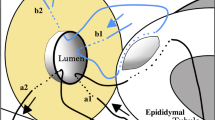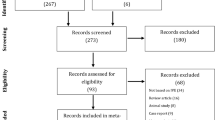Abstract
Purpose
To evaluate the efficacy of microsurgical two-suture single-armed longitudinal intussusception vasoepididymostomy for patients with obstructive azoospermia (OA) attending our institution.
Methods
The study enrolled all patients with OA due to epididymal obstruction who had undergone microsurgical two-suture single-armed longitudinal intussusception vasoepididymostomy in the study hospital from July 2009 to November 2012. All procedures were performed by a single surgeon in a university teaching hospital. The inclusion criteria include: documented azoospermia in at least two consecutive semen samples collected 6 weeks apart, with normal ejaculate volume and semen pH. All patients had at least one normal-sized testis and normal FSH levels. All patients had had testicular biopsies to confirm active spermatogenesis.
Results
Twenty-two patients with OA due to epididymal obstruction had undergone 22 microsurgical vasoepididymostomy procedures. The mean age of patients and their female partners was 31 and 25 years, respectively. All procedures were performed by Monoski’s two single-armed suture longitudinal intussusception techniques. The mean operating time of unilateral and bilateral procedures was 145 and 214 min, respectively. The median duration of follow-up was 18 (range, 6–30) months. The overall patency rate was 59 %; being 50 and 70 % for unilateral and bilateral procedures, respectively. The overall paternity rate was 36 %. Natural pregnancy was achieved in three cases, and assisted reproduction was used in five using fresh ejaculated semen.
Conclusions
Two-suture single-armed longitudinal intussusception microsurgical vasoepididymostomy is a feasible option for couples with male factor infertility due to epididymal OA. Reasonable patency outcomes were achieved in the present series of cases. Individualized counseling, with expectations based on obstructive etiology and anticipated surgical outcomes, should be offered to couples before resorting to assisted reproduction. Longer follow-up is required to ascertain long-term patency, pregnancy outcomes, and late failures.

Similar content being viewed by others
References
Lee R, Li PS, Schlegel PN, Goldstein M (2008) Reassessing reconstruction in the management of obstructive azoospermia: reconstruction or sperm acquisition? Urol Clin North Am 35:289–301
Practice Committee of American Society for Reproductive Medicine in collaboration with Society for Male Reproduction and Urology (2008) The management of infertility due to obstructive azoospermia. Fertil Steril 90:121S–124S
Sutcliffe AG, Ludwig M (2007) Outcome of assisted reproduction. Lancet 370:351–359
Van Voorhis BJ (2007) Clinical practice. In vitro fertilization. N Engl J Med 356:379–386
Pavlovich CP, Schlegel PN (1997) Fertility options after vasectomy: a costeffectiveness analysis. Fertil Steril 67:133–141
Donovan JF Jr, DiBaise M, Sparks AE, Kessler J, Sandlow JI (1998) Comparison of microscopic epididymal sperm aspiration and intracytoplasmic sperm injection/in vitro fertilization with repeat microscopic reconstruction following vasectomy: is second attempt vas reversal worth the effort? Hum Reprod 13:387–393
Kolettis PN, Thomas AJ Jr (1997) Vasoepididymostomy for vasectomy reversal: a critical assessment in the era of intracytoplasmic sperm injection. J Urol 158:467–470
Lee R, Li PS, Goldstein M, Tanrikut C, Schattman G, Schlegel PN (2008) A decision analysis of treatments for obstructive azoospermia. Hum Reprod 23:2043–2049
Goldstein M, Tanrikut C (2006) Microsurgical management of male infertility. Nat Clin Pract Urol 3:381–391
Berger RE (1998) Triangulation end-to-side vasoepididymostomy. J Urol 159:1951–1953
Marmar JL (2000) Modified vasoepididymostomy with simultaneous double needle placement, tubulotomy and tubular invagination. J Urol 163:483–486
McCallum S, Li PS, Sheynkin Y, Su LM, Chan P, Goldstein M (2002) Comparison of intussusception pull-through end-to-side and conventional end-to-side microsurgical vasoepididymostomy: prospective randomized controlled study in male wistar rats. J Urol 167:2284–2288
Chan PT, Li PS, Goldstein M (2003) Microsurgical vasoepididymostomy: a prospective randomized study of 3 intussusception techniques in rats. J Urol 169:1924–1929
Chan PT, Brandell RA, Goldstein M (2005) Prospective analysis of outcomes after microsurgical intussusception vasoepididymostomy. BJU Int 96:598–601
Monoski MA, Schiff J, Li PS, Chan PT, Goldstein M (2007) Innovative single-armed suture technique for microsurgical vasoepididymostomy. Urology 69:800–804
Mansi MK (1995) Scrotal exploration in 123 azoospermic patients: the results of surgery for obstructive azoospermia. Ann Saudi Med 15:609–613
World Health Organization (1999) Laboratory manual for the examination of human semen and sperm-cervical mucus interaction, 4th edn. Cambridge University Press, New York
Schiff J, Chan P, Li PS, Finkelberg S, Goldstein M (2005) Outcome and late failures compared in 4 techniques of microsurgical vasoepididymostomy in 153 consecutive men. J Urol 174:651–655
Kumar R, Mukherjee S, Gupta NP (2010) Intussusception vasoepididymostomy with longitudinal suture placement for idiopathic obstructive azoospermia. J Urol 183:1489–1492
Peng J, Yuan Y, Zhang Z, Gao B, Song W, Xin Z, Jin J, Liu W, Guo Y (2012) Patency rates of microsurgical vasoepididymostomy for patients with idiopathic obstructive azoospermia: a prospective analysis of factors associated with patency-single-center experience. Urology 79:119–122
Zhang GX, Bai WJ, Xu KX, Wang XF, Zhu JC (2009) Clinical observation of loupe-assisted intussusception vasoepididymostomy in the treatment of obstructive azoospermia (analysis of 49 case reports). Asian J Androl 11:193–199
Zhao L, Deng CH, Sun XZ, Chen Y, Wang WW, Zhao LY, Zeng LY, Tu XA (2013) A modified single-armed technique for microsurgical vasoepididymostomy. Asian J Androl 15:79–82
Acknowledgments
This study was supported by a grant from the College of Medicine Research Center, Deanship of Scientific Research, King Saud University, Riyadh, Saudi Arabia.
Conflict of interest
The author reports no conflict of interest.
Author information
Authors and Affiliations
Corresponding author
Rights and permissions
About this article
Cite this article
Binsaleh, S. Two-suture single-armed longitudinal intussusception vasoepididymostomy for obstructive azoospermia: report of patients characteristics and outcome. Int Urol Nephrol 46, 2271–2277 (2014). https://doi.org/10.1007/s11255-014-0835-6
Received:
Accepted:
Published:
Issue Date:
DOI: https://doi.org/10.1007/s11255-014-0835-6




